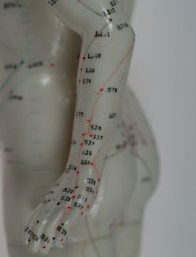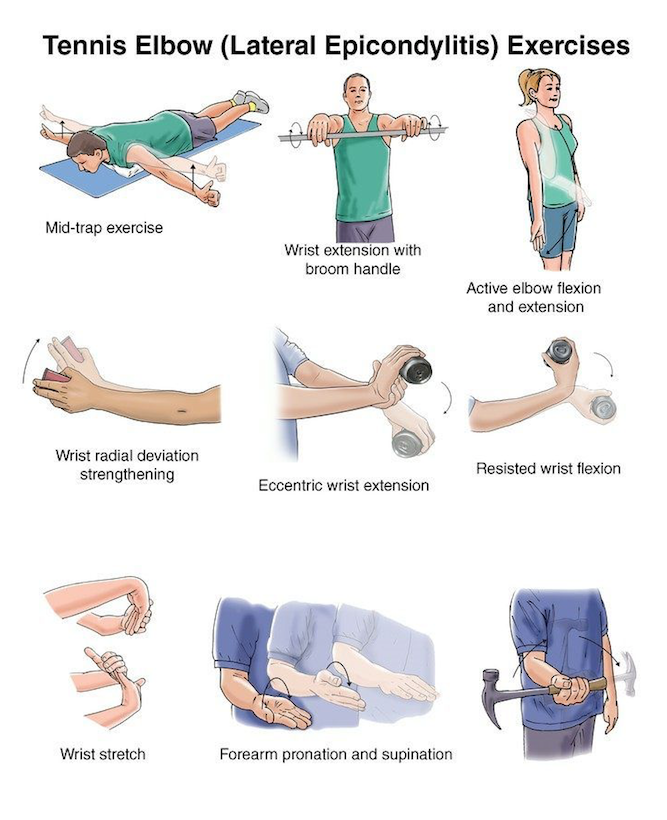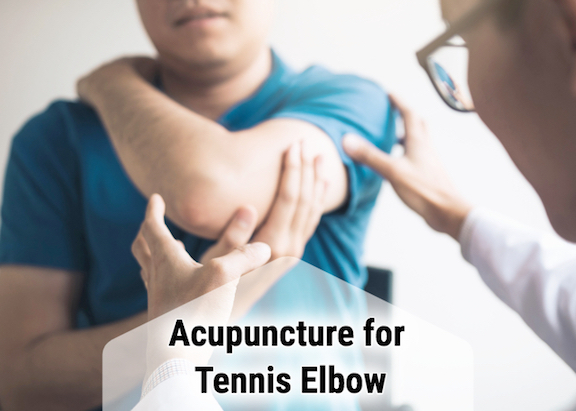Acupuncture for the treatment of lateral epicondylitis, commonly known as tennis elbow, is gaining in popularity. Even though the condition is labelled as “tennis elbow”, tennis players only make up about 10% of the patient population for the condition, and the annual incidence of tennis elbow in the United States is one to three percent. Unfortunately, many individuals who are affected by tennis elbow may not even know that acupuncture is an option for them. Patients may often turn to medications or other drugs that don’t fully work, or they just deal with the pain. Depending on the severity, patients may find relief with acupuncture, but since it isn’t as well known, they will more than likely turn to western medicine methods first.
What is Tennis Elbow?

Tennis elbow, is the inflammation of the outside of the elbow, a bone called the lateral epicondyle. The outer area of the elbow becomes painful as a result of tearing and overuse of the tendons and muscles in this area.
The primary muscles involved in Tennis Elbow are:
- Extensor carpi radialis brevis (most common)
- Extensor carpi ulnaris
- Extensor digitorum communis
- Extensor carpi radialis longus
The pain that is felt from tennis elbow often spreads into the forearm and wrist, making it difficult to perform daily tasks. The pain will either be worse doing daily tasks, or will make it difficult to perform the task in its entirety.
Common symptoms of tennis elbow include:
- Weakness of the wrist on the affected elbow
- Tenderness on the medial side of the elbow
- Tightness in the forearm
- Elbow stiffness and pain
- Struggling to hold objects
- Trouble gripping or pinching objects
- Decreased elbow movement
While tennis elbow is often associated with athletes, they are not the only ones who suffer from it. Tennis elbow is caused by overuse and repetitive motions, and is the most common overuse injury being observed up to 10 times more frequently than medial epicondylitis. It is also common in all types of actions or jobs that feature the types of motions that lead to tennis elbow.
Occupations and activities that have a higher risk of developing tennis elbow include:
- Plumbers
- Carpenters
- Butchers
- Painters
- Electricians
- Gardeners
- Golfers
- Dentists
- Musicians
- Chefs
- Mechanics
- Tennis players
- Weight lifting
- Typing
- Knitting
Essentially, any person who has a primary job of using this part of their elbow or forearm repetitively day to day can be at risk for tennis elbow. Tennis elbow develops between the ages of 30 – 50 years. Occupation, and obviously, participating in certain sports on a frequent basis, may also contribute to the development of tennis elbow.
Common western medicine treatment approaches for tennis elbow are physical therapy, NSAIDs (non-steroidal anti-inflammatory drugs), bracing, icing, steroid injections, and sometimes even surgery. What many people are unaware of is that acupuncture is a modality that may be able to intervene without having to resort to surgery or reduce and possibly completely cut out NSAIDs with possible harmful side effects.
Acupuncture and Tennis Elbow

As shown above, there are a host of treatment options in western medicine for tennis elbow, however, those treatments more often than not only end up suppressing symptoms temporarily. Suppressing symptoms, as we know as eastern medicine providers, does not equate to healing. In TCM (Traditional Chinese Medicine), lateral epicondylitis is traditionally known as Zhou Lao which means “pain at the outside elbow”, and falls into the category of Bi Zheng or painful obstruction syndrome. Acupuncture works for tennis elbow by decreasing the hypertonicity of the extensor muscles, and allowing more Qi to flow throughout the body. The blocked energy from tennis elbow builds up too much pressure causing ongoing pain and restriction in flexibility.
According to TCM, tennis elbow is caused by:
- Stagnation of Qi and Blood and invasion of pathogenic factors such as Dampness, Wind, and Cold.
- Internal deficiency of Qi and Blood causing not nourishing tendons and joints.
- Liver Qi stagnation
There are obviously other potential causes, but these are the main ones to look out for when treating a tennis elbow patient. It is also important to bear in mind that any pre-existing internal deficiency will also predispose the body to the invasion of any pathogenic factors.
Tennis Elbow Acupuncture Points & Herbs
When treating lateral epicondylitis, the acupuncturist should choose appropriate points according to the TCM pattern that the patient is presenting with which could be any variety of select points.
Tennis Elbow Acupuncture Points:
- LI10 – Arm Three Li – Shou San Li – located 2 cun below LI11, and used for shoulder, elbow, and wrist pain issues.
- LI12 – Elbow Bone Hole – Zhou Liao – located on the radial side of the upper arm 1 cun above LI11, and is a local point for pain in the upper arm and elbow.
- LI13 – Arm Five Li – Shou Wu Li – located 3 cun above LI11, and is also a local point for pain in the upper arm and elbow.
- LI9 – Upper Ridge – Shang Lian – 3 cun below LI11, and is also a local point for pain in the elbow, shoulder, and arm pain in general.
- LU5 – Cubit Marsh – Chi Ze – located at the cubital crease on the radial side of the biceps brachii tendon, and is used for elbow pain (tennis elbow specifically) among other issues.
- ST12 – Empty Basin – Quepen – located 4 cun lateral of the anterior midline, and is used for tennis elbow.
Acupuncture points for typical TCM patterns with tennis elbow:
- Qi & Blood Stagnation with Cold – LI5, LI11, LI7, LV3, KD4
- Wind-Cold Painful Obstruction – ST40, LU7, DU14, SI12, LI11, LI5, SP9, SJ4
- Qi & Blood Stagnation with Liver Blood Deficiency – REN6, ST36, LI1, LI5, SJ3, SJ8, UB20, SP6, LV3, LV8, GB34
Herbs for tennis elbow by TCM pattern:
- Fang Feng Tang – Wind-Cold – goal of treatment is to dispel wind and eliminate external pathogenic factors. This herb relieves Wind-Cold-Damp, invigorates blood circulation, disperses heat, relieves pain, and produces sweat.
- Huang Qi Gui Zhi Wu Wu Tang – Wind-Cold bi with Qi and Blood deficiency – goal of treatment is to nourish the blood, warm and unblock the channel, and strengthen Qi. This herb tonifies Qi and Blood, harmonizes Yin and Yang, relieves pain, unblocks painful obstruction, and warms and harmonizes the channels.
- Wang Qiu Zhou Tang – Wind-Cold-Damp bi with Blood stagnation – goal of treatment is to invigorate blood, break up blood stasis, stop pain, and dispel Wind-Cold-Damp. This herb stops pain, invigorates the blood, unblocks the collaterals, breaks up blood stasis, and dispels Wind-Cold-Damp.
- Shen Tong Zhu Yu Tang – Blood stagnation due to repetitive motion – goal of treatment is to break up stagnation, and invigorate blood. This herb relieves pain, removes blood stagnation, invigorates circulation of Qi and Blood, and unblocks painful obstruction.
In addition to these example points and herbs, Tui Na is a great compliment to acupuncture treatment as it allows for maximum circulation and flow between the meridians. Treatment should consist of 2-3 times a week for several weeks depending on how the patient presents.
Tennis Elbow Treatment

Acupuncturists should also recommend that patients rest their elbow for at least 2 weeks, and if that is not fully possible, to at least wear a tennis elbow brace. There are also tennis elbow exercises that patients can do at home to strengthen the forearm muscles and stretches to increase flexibility. These exercises include things like wrist extension and flexion, squeezing a ball, wrist extension with a broom handle, elbow flexion and extension, and more.
Will Acupuncture Help Tennis Elbow Patients?
Using acupuncture to treat tennis elbow is increasingly becoming a go-to treatment option for those who suffer from this condition day to day. Although more research is needed, current research shows promising results for a natural healing modality like acupuncture. A systemic review released just in March of 2020, Effectiveness of Acupuncture for Lateral Epicondylitis, concluded that although further study is needed, the results of the meta-analysis showed that acupuncture may be “more effective than drugs and blocking therapy in improving the clinical efficiency rate.” As with many other conditions, a call for larger scale studies is urged by researchers as acupuncture could be a significant help for patients seeking treatment for tennis elbow.
To learn more about Acupuncture for Tennis Elbow, and earn 6 CEUs/PDAs, click here.

Have more knowledge or an acupuncture/TCM specialty you want to call attention to and share?
Become our next Acupuncturist of the Month!
Share your knowledge, highlight your work, and lift up the acupuncture profession for you and other professionals!
Email us at acucontinuingeducation@gmail.com or click here today to learn more.
